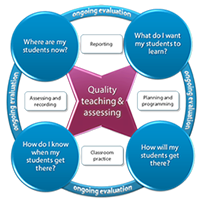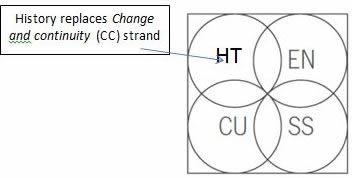Planning
Aim
|
Curriculum planning and programming aims to:
|
Schools will provide teaching and learning programs that enable all students to develop the knowledge, skills and values to ensure that they maximise their potential to live fulfilling, productive and responsible lives.
|
Your school context
|
The school context can be analysed according to:
The diagram on the right locates planning in the teaching and learning cycle. |
Click the diagram and view the Teaching and learning cycle tab for more information. |
||||
The Board of Studies NSW History K–10 Syllabus provides teachers with information about learning in history from Kindergarten to Year 10. This continuum of learning supports curriculum planning and programming for the increasing complexity of knowledge, understanding and skills based on the syllabus outcomes and content descriptions. The continuum of learning supports the transition between stages, especially from Stage 3 to Stage 4, where both primary and secondary teachers can cross reference learning across these two stages. The role of the concepts and skills descriptions included in the syllabus supports teachers to differentiate learning in all stages.
|
|||||
Curriculum planning process
|
A detailed knowledge of the syllabus underpins the curriculum planning process. Referencing the syllabus requirements, including outcomes and their supporting syllabus content or subject matter descriptions for primary HSIE, including history K–6 and secondary history 7–10, ensures that planning is strategic and manageable.
Planning for primary school needs to consider history in conjunction with the HSIE strands of Cultures, Environments and Social Systems and Structures of HSIE K–6. Some aspects of the content in the history syllabus may integrate with the subject matter of these 3 strands, as illustrated by this diagram.
Teachers planning for secondary history need to consider:
When, how and where should ‘overviews’ be used? These are identified at the beginning of each period of world history.
|
An overview for planning HSIE and history syllabuses
Scope and sequences are an important tool to ensure content consistency is taught for all students. Each school will apply an individual approach.
A scope and sequence maps what will be taught and when this is to happen. It will show syllabus outcomes/content, organised into coordinated topics that are balanced and time effective, which reflect the context of your school.
Each primary school, or faculty including history, will need to consider both a collaborative process for developing a scope and sequence and the amount of detail and the format this is recorded in.
|
|
Review and discuss the sample visual depiction (.pdf 127kB) of how to incorporate history into HSIE as a scope and sequence. Even though developing a scope and sequence is not a requirement of this course, consider the scope of this model for developing a scope and sequence that integrates the 4 strands of HSIE. |
|
|
Use a chart to collaboratively map the HSIE and history syllabus outcomes and content to support balanced teaching across the 4 strands. A HSIE with history K–6 continuum of learning is the goal of a scope and sequence with a considered transition from one stage to the next. |
A scope and sequence needs to include:
-
the title of each unit
-
the sequence of each unit for the year/stage
-
the duration of each unit
-
the syllabus outcomes included in each unit (these are commonly represented by outcomes codes)
-
any specific-subject requirements (for example, text requirements, student research projects, a site study or time allocated to major aspects of a course)
-
additional information based on common practice in particular subject areas or particular school requirements.
|
|
Visit the Board of Studies NSW website for some sample history 7–10 scope and sequences or refer to a scope and sequence of your own |
Schools need to regularly revise and cross reference their scope and sequence to the syllabus requirements, to ensure that changes in school context, assessment schedules, resources and staff expertise are reflected positively in school planning.
Presenter notes
Indicative time: 45 minutes
This tab provides participants with an opportunity to:
-
learn more about planning for history using the history K–6 and 7–10 syllabuses
-
build the capacity to design a unit of learning using specific planning processes.
In particular, participants will:
-
reflect on the significance and purpose of planning for teaching and learning in history
-
explore how to plan within the school and classroom context
-
explore the continuum of learning in the syllabus
-
integrate history with the other HSIE strands (primary only)
-
become aware of unique needs when planning for History in 7–10 (secondary only)
-
review scope and sequence requirements
Provide time for participants to complete the tasks included in the Activity booklet as required. Participants may prefer to work in pairs for these activities. Allow time for reflection or discussion as appropriate.
-
Access the link to the Curriculum Planning and Programming for Quality Teaching, Assessing and Reporting document.
-
Reflect on the statements about planning for History K–10. Encourage discussion and share the responses.
-
Access the video link Hit without being hit – the Boffin, the Builder, the Bombardier – Episode 1.
-
Engage with the Quality teaching and assessing diagram.
-
Encourage a review of factors influencing school context and record these in the Activity booklet under Your school and context for history K–10.
-
View and discuss the PowerPoint presentation History K–10 continuum of learning, then examine and discuss how the continuum builds in complexity for student outcomes.
-
Provide the resources to download or photocopy stage K–6 content pages to highlight and annotate (primary only).
-
Complete the 7–10 history pattern of learning proforma in the activity booklet (secondary only).
-
Refer teachers to the Building Capacity resource and complete the questions in the activity booklet on how to address the overviews (secondary only).
-
Use the sample a scope and sequences provided to promote discussion about the importance of planning and programming for the History K–10 syllabus.






